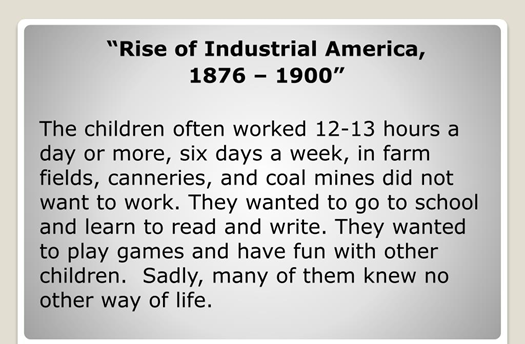Unit 7: Problems in Industrial America (1867-1935) Overview
Unit 7: Problems in Industrial America (1867-1935)

Unit 7: Problems in Industrial America (1867-1935)

Unit 7: Problems in Industrial America (1867-1935)
Effects of the Industrial Revolution
Now that we have looked at how and why the Industrial Revolution occurred, it’s time to consider its effects on people. We learned that industrial production increased tremendously, bringing wealth and power to Great Britain throughout the 19th century. But we have yet to explore the effects of industrialization on society, on the daily living and the working conditions of common people. What was life like for the average industrial worker? Was living in a new industrial city and working in a factory an improvement over life in the countryside? Did the new factory life change for the better the roles of family members, including women and children? Were people healthier? In general, did the Industrial Revolution improve life for most people? To answer these questions, we’ll look at various primary source accounts to gather evidence from the people that actually lived through this time period.
Since the Industrial Revolution was so new at the end of the 18th century, there were initially no laws to regulate new industries. For example, no laws prevented businesses from hiring seven-year-old children to work full time in coal mines or factories. No laws regulated what factories could do with their biohazard waste. Free-market capitalism meant that the government had no role in regulating the new industries or planning services for new towns. And those who controlled the government liked it that way—only a small minority of people, the wealthiest, could vote in England at this time. So during the first phase of the Industrial Revolution, between 1790 and 1850, British society became the first example of what happens in a country when free-market capitalism has no constraints. You will learn about the effects of the Industrial Revolution on living and working conditions, urbanization (the growth of cities), child labor, public health, working class family life, the role of women, the emerging middle class, and economic growth and income. You will be asked to reflect about what role, if any, the government should have taken to improve life in the new industrial cities.
This unit emphasizes economic, political, and social problems caused by the Industrial Revolution.
Unit Focus
- Problems of farmers and industrial workers
- How farmers organized to pass laws
- How industrial workers organized to form unions
- Reasons many immigrants came to America
- Reasons labor force was greatly increased
- Reasons urban growth became a major problem
Vocabulary
Lesson Reading
Videos and Interactives (Click on Images to View Content)

